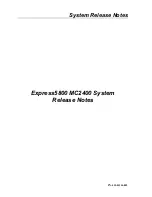Reviews:
No comments
Related manuals for M19A System

NECCare Gold Express5800/320Fd
Brand: NEC Pages: 10

SV8500
Brand: NEC Pages: 84

NEC Express5800 Series
Brand: NEC Pages: 6

3PAR StoreServ
Brand: HPE Pages: 174

iDataPlex dx320 6385
Brand: IBM Pages: 60

UniServer E3200 G3
Brand: H3C Pages: 401

NovaScale R410B F2
Brand: Bull Pages: 38

PRIMERGY B120
Brand: Fujitsu Siemens Computers Pages: 68

GP 7000F
Brand: Fujitsu Pages: 200

NP33 Series
Brand: DATONG Pages: 23

1-Port
Brand: IBM Pages: 15

LANTIME M600 MRS
Brand: Meinberg Pages: 160

Dock Server
Brand: Teledyne Pages: 228

Access Server M
Brand: SSS Siedle Pages: 28

ZLAN9153
Brand: ZLAN Pages: 16

ZLAN8303
Brand: ZLAN Pages: 17

SE7520AF2
Brand: Intel Pages: 256

ixia Application Server
Brand: Keysight Pages: 37

















